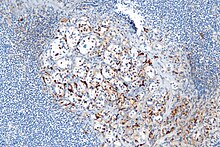
A sustentacular cell is a type of cell primarily associated with structural support, they can be found in various tissues.
- Sustentacular cells of the olfactory epithelium (also called supporting cells or Sertoli cells) have been shown to be involved in the phagocytosis of dead neurons, odorant transformation and xenobiotic metabolism.
- One type of sustentacular cell is the Sertoli cell, in the testicle. It is located in the walls of the seminiferous tubules and supplies nutrients to sperm. They are responsible for the differentiation of spermatids, the maintenance of the blood-testis barrier, and the secretion of inhibin, androgen-binding protein and Müllerian-inhibiting factor.
- The organ of Corti in the inner ear and taste buds also contain sustentacular cells.
- Another type of sustentacular cell is found with glomus cells of the carotid and aortic bodies.
- About 40% of carcinoids have a scattering of sustentacular cells, which stain positive for S-100.
References
- "Sustentacular cell - Biology-Online Dictionary | Biology-Online Dictionary". www.biology-online.org. Archived from the original on 2015-10-11. Retrieved 2019-03-18.
- Suzuki, Yuko; Takeda, Masako; Farbman, Albert I. (1996). "Supporting cells as phagocytes in the olfactory epithelium after bulbectomy". Journal of Comparative Neurology. 376 (4): 509–517. doi:10.1002/(sici)1096-9861(19961223)376:4<509::aid-cne1>3.0.co;2-5. ISSN 1096-9861. PMID 8978466. S2CID 25026550.
- Heydel, Jean-Marie; Coelho, Alexandra; Thiebaud, Nicolas; Legendre, Arièle; Bon, Anne-Marie Le; Faure, Philippe; Neiers, Fabrice; Artur, Yves; Golebiowski, Jérôme; Briand, Loïc (September 2013). "Odorant-Binding Proteins and Xenobiotic Metabolizing Enzymes: Implications in Olfactory Perireceptor Events: Odorant-Binding Proteins and Metabolizing Enzymes". The Anatomical Record. 296 (9): 1333–1345. doi:10.1002/ar.22735. PMID 23907783.
- Zhuo, Xiaoliang; Gu, Jun; Behr, Melissa J.; Swiatek, Pam J.; Cui, Huadong; Zhang, Qing-Yu; Xie, Yingqiu; Collins, Doris N.; Ding, Xinxin (February 2004). "Targeted Disruption of the Olfactory Mucosa-Specific Cyp2g1 Gene: Impact on Acetaminophen Toxicity in the Lateral Nasal Gland, and Tissue-Selective Effects on Cyp2a5 Expression". Journal of Pharmacology and Experimental Therapeutics. 308 (2): 719–728. doi:10.1124/jpet.103.060301. ISSN 0022-3565. PMID 14610229. S2CID 2953594.
- Jones, Richard E.; Lopez, Kristin H. (2014). "The Male Reproductive System". Human Reproductive Biology. pp. 67–83. doi:10.1016/B978-0-12-382184-3.00004-0. ISBN 978-0-12-382184-3.
- Burke, AP; Sobin, LH; Federspiel, BH; Shekitka, KM (November 1989). "Appendiceal carcinoids: correlation of histology and immunohistochemistry". Modern Pathology. 2 (6): 630–7. PMID 2479945.
| Smell | |||||||||||||||
|---|---|---|---|---|---|---|---|---|---|---|---|---|---|---|---|
| Microanatomy | |||||||||||||||
| Olfactory nerve | |||||||||||||||
| Brain areas involved in smell |
| ||||||||||||||
| General | |||||||||||||||
This anatomy article is a stub. You can help Misplaced Pages by expanding it. |